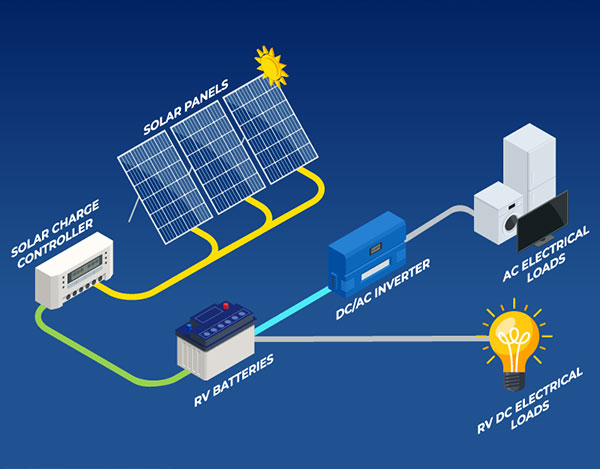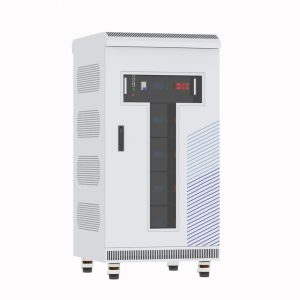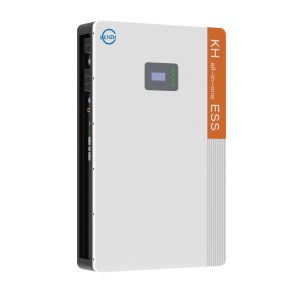Introduction
A solar cell is a semiconductor photovoltaic device that uses the photovoltaic effect to convert solar energy system directly into electricity. It is mainly a photovoltaic device made by utilizing the principle of semiconductor PN junction, and it can convert the solar energy on its surface into electric energy output under sunlight irradiation, and the conversion efficiency is high, so it is called a solar cell.

How solar cells work
Solar energy is a kind of radiant energy, the use of solar power generation needs to be converted into electrical energy, which must be with the help of energy converters. There are two ways to generate solar power, one is the light – heat – electricity conversion method, and the other is the direct conversion of light – electricity.
① Light – heat – electricity conversion method by using solar radiation to generate electricity, generally by the solar collector will be absorbed by the thermal energy converted into steam, and then drive the turbine generator to generate electricity.
② photoelectric direct conversion method using the photoelectric effect will be directly converted to solar radiation energy into electricity, and light – the basic device is the conversion of solar cells.

How is the solar cell market today?
A solar cell is a device that utilizes light energy to convert it into electricity and has a wide range of application prospects. Currently, solar cells are used in a wide range of domestic and industrial applications, including balcony solar systems, commercial industrial energy storage.
The use of solar cells is becoming more and more common, mainly thanks to the following factors:
1. Renewable energy: solar energy is a clean energy source and is environmentally friendly as it does not produce greenhouse gases and air pollutants compared to traditional fossil fuels.
2. Cost reduction: with the advancement of technology and scale effect, the manufacturing cost of solar cells continues to decline.
3. Policy support: the state has introduced policy measures to encourage the development of renewable energy, such as subsidy policies, and tax incentives. This policy support for the solar industry provides a favorable environment for development.
Types of Solar battery
Lead Acid battery
Lead-acid batteries have been a mainstay of the energy storage industry for decades, known for their reliability and cost-effectiveness. There are two main types of lead-acid batteries: flooded lead-acid batteries and sealed lead-acid batteries.
Flooded lead-acid batteries require regular maintenance to check water levels and ensure optimal performance. On the other hand, sealed lead-acid batteries, including absorbent glass mats (AGM) and gel batteries, are maintenance-free options that offer greater safety and versatility.
Lithium ion-iron phosphate (LiFePO4) and -Lithium ion-nickel cobalt oxide (NMC)
-
All-in-one Energy Storage System
Battery Energy Storage System Container | BESS
-
All-in-one Energy Storage System
665 Volts Battery Energy Storage System ESS Lifepo4 Battery Pack Solar Batteries
-
All-in-one Energy Storage System
48V 400Ah 20KW LiFePO4 Battery Server Rack Battery Lithium Battery Energy Storage Syetem
-
All-in-one Energy Storage System
5Kw 5Kwh LiFePO4 Lithium Battery All in one Inverter Powerwall Battery – KHLiTech ESS
Lithium-ion batteries have gained popularity in recent years due to their higher energy density, longer lifespan, and lighter weight than conventional lead-acid batteries. Among the lithium-ion variants suitable for solar applications, lithium iron phosphate (LiFePO4) batteries are known for their excellent thermal stability and safety features. Another noteworthy variant is the nickel manganese cobalt oxide (NMC) lithium battery, which balances high energy density with power capability and is ideal for demanding solar applications.
Fluid Flow Battery
Fluid flow batteries are an innovative approach to energy storage, offering unique advantages such as scalability and long cycle life. What makes vanadium redox flow batteries stand out in this field is their ability to decouple power and energy, allowing flexibility to customize them to the requirements of a specific solar system. Liquid flow cells excel in applications that require long storage times or frequent deep discharges, making them ideal for grid-connected solar installations designed for maximum efficiency.
How to choose the best solar cells for your needs?
Capacity and Voltage
Choosing the right solar battery requires considering the capacity and voltage requirements of a particular solar system. Capacity is usually measured in kilowatt-hours (kWh) and indicates how much energy the battery can store. The capacity of the battery must match your energy consumption patterns to ensure a reliable power supply.
It is also critical to evaluate voltage requirements for solar panel and inverter compatibility. Proper voltage ratings ensure efficient energy transfer between components and optimize system performance.
Cycle life and warranty
Cycle life is the number of charge/discharge cycles a solar cell can undergo while maintaining its performance level over time. The longer the cycle life, the better the durability and cost-effectiveness in the long run. When choosing a solar battery, it’s important to check the manufacturer’s instructions for cycle life expectations based on typical usage.
It is also critical to consider the warranty terms, which ensure that the battery will not fail prematurely or deteriorate significantly over a specified period. Choosing a battery with an extended warranty provides peace of mind and added value in terms of long-term reliability.
Depth of Discharge (DoD)
Depth of discharge (DoD) is a key factor when choosing a solar cell, as it determines how much of the stored energy can be utilized before it needs to be recharged. The higher the Depth of Discharge percentage, the more energy is available to the battery but may affect the life of the battery.
It is recommended to strike a balance between maximizing available capacity and preserving battery life by selecting a DoD level that is consistent with your daily energy consumption patterns. Understanding and tailoring the DoD to your specific needs will help extend the cycle life of your battery.
Proper Placement and Ventilation
Solar cells should be placed in a well-ventilated area to prevent overheating, which can reduce their efficiency and lifespan. Ideally, solar cells should be installed in a cool, dry place away from direct sunlight and temperature extremes.
Adequate ventilation is essential to expel heat generated during the charging and discharging process. Proper location not only ensures optimal performance, but also minimizes the risk of fire due to overheating.
Regular Inspection and Cleaning
Routine inspections of your solar cell system are essential for early detection of potential problems and to ensure uninterrupted operation. Regularly check for any signs of physical damage, leaks or unusual behavior, such as overheating during charging. Cleaning is also critical; make sure no corrosion or dirt buildup on the battery terminals could prevent proper electrical contact.
Advantages of Solar Panel Batteries
Save money
Solar panels can significantly reduce electricity bills. Once installed, the electricity generated by solar panels during the day can be used directly to meet the electricity needs of your home or business, reducing the need to purchase electricity from the grid. Over time, the amount of money saved on electricity bills can cover the cost of installing the solar system and even generate a financial return.
Energy Savings
Solar energy is a virtually endless natural resource, and using solar panels to convert solar energy into electricity helps to reduce dependence on traditional energy sources such as fossil fuels. This not only reduces the pressure on the earth’s finite resources but also helps to reduce the overall consumption of energy.
Going Green
The electricity generated by solar panels is completely clean and produces no greenhouse gases or other pollutants. This is extremely important for mitigating climate change, improving air quality, and protecting the environment. By going solar, individuals and businesses can reduce their carbon footprint and contribute to a greener, more sustainable future.
Unaffected by grid failures
With solar panels in place, a home or business can continue to operate even in the event of a power outage with the power stored in solar cells. This is especially important in areas that face frequent power outages.
Which solar storage option to choose?
DC-coupled energy systems
The DC power from the photovoltaic modules is stored, via a controller, in a battery bank, and the grid can also charge the battery via a bidirectional DC-AC converter. The pooling point of the energy is at the DC battery terminal.

The working principle of DC coupling: when the PV system is running, the battery is charged through the MPPT controller; when there is a demand from the electrical load, the battery will release the power, and the current is set by the load. The storage system is connected to the grid, if the load is small and the battery is full, the PV system can supply power to the grid. When the load power is greater than the PV power, the grid and the PV can supply power to the load at the same time. Because neither the PV power nor the load power is stable, it depends on the battery to balance the system energy.
AC-coupled energy systems
AC coupling, as shown in the figure below, the DC power from the PV modules is converted to AC power through an inverter, which is fed directly to the load or to the grid, which can also be charged to the battery through a bi-directional DC-AC bi-directional converter. The pooling point of energy is at the AC end.

The working principle of AC coupling: it contains a PV power supply system and a battery power supply system. The photovoltaic system consists of a photovoltaic array and a grid-connected inverter; the battery system consists of a battery bank and a bidirectional inverter. These two systems can either operate independently without interfering with each other, or they can be separated from the grid to form a micro-grid system.
Pros And Cons
(1) Analyzed from the cost point of view, DC-coupling and AC-coupling are different in the configuration of solar energy storage system. A DC-coupled system usually includes a controller, a bidirectional inverter, and a switching switch, while an AC-coupled system involves a grid-connected inverter, a bidirectional inverter, and a power distribution cabinet. Considering the lower cost of the controller compared to the grid-connected inverter, and the switching switch is more economical than the distribution cabinet, the DC-coupled program has more advantages in equipment and installation costs, especially when the DC-coupled program adopts the integrated control and inverter all-in-one machine, its cost advantage is more obvious.
(2) In terms of applicability, DC-coupled and AC-coupled systems have their own characteristics. In the DC-coupled system, the controller, battery and inverter are more closely connected to form a series connection, which makes the system less flexible, but for the newly built off-grid system, it is able to customize the design according to the user’s specific load power and power demand, which is more applicable. However, DC-coupled systems are generally suitable for small systems of 500 kW and below. In contrast, AC-coupled systems offer greater flexibility due to the parallel connection of the grid-connected inverter, batteries and bi-directional inverter. For cases where a PV system is already installed and a storage system is desired to be added, AC coupling would be more appropriate as it allows for later additions of batteries and bi-directional inverters without affecting the existing PV system configuration.
(3) DC-coupled and AC-coupled systems each have advantages and disadvantages in terms of efficiency comparisons. If the user’s daytime electricity consumption is greater than the nighttime electricity consumption, the AC-coupled system is more appropriate because the PV modules can be directly supplied to the load through the grid-connected inverter, resulting in an efficiency of more than 96%. On the other hand, for users who use less electricity during the day and more at night, a DC-coupled system is more favorable because the PV power can be stored directly in the battery through the controller, resulting in an efficiency of about 95% or more. AC-coupled systems in this case require two energy conversions – the DC power generated by the PV is first converted to AC power and then converted back to DC power for storage via a bidirectional inverter, resulting in a lower efficiency of around 90%.
How much do solar cells cost?
|
Type
|
Size
|
costs
|
|---|---|---|
|
lead acid
|
Common electric car batteries or starter batteries
|
$250/kWh
|
|
Li-ion
|
Gropu 24- Group 27
|
$800/kWh
|
|
Flow battery
|
It's a big container.
|
$350/ kWh
|
Solar Battery Brands
At Keheng, a leading Li-ion battery manufacturer in China, we understand that there are many great solar cell brands in the market. These brands include but are not limited to, SunPower, LG, Panasonic, Canadian Solar, Trina Solar, Jinko Solar, Tesla, and many more. Each brand has its unique strengths and features, providing consumers around the world with a wealth of choices.
However, in this highly competitive market, we, Keheng, remain committed to providing our customers with the highest quality lithium-ion batteries and battery packs with a focus on innovation and quality. Our manufacturing facilities include a dedicated battery factory and a battery pack facility, enabling us to provide a diverse range of battery energy solutions for a variety of projects.
Our products have received numerous certifications such as MSDS, UN38.3, IEC, UL, CB, and ISO9001:2015. Whether you are looking for electric vehicle batteries, industrial batteries, or energy storage batteries, we can meet your every need.
What are other types of solar cells made of?
Monocrystalline Silicon Cells
Monocrystalline silicon is a crystal with basically identical lattice orientation, it has a diamond lattice, hard and brittle crystals, metallic luster, and can conduct electricity, but the conductivity is not as good as metal, and with the increase in temperature, it is a good semiconductor material.
The monocrystalline silicon solar cell manufacturing process is high, so monocrystalline silicon is expensive.
Polycrystalline Silicon Cells
Polycrystalline silicon solar cell production is equal to monocrystalline silicon cells, or even larger, is one of the main products in the photovoltaic cell market. Compared with monocrystalline silicon batteries, polycrystalline silicon prices are lower commercial polycrystalline silicon battery module conversion efficiency is generally 12% ~ 14%, and has been produced up to 17% ~ 19.8% conversion efficiency of polycrystalline silicon. Semiconductor properties are extremely important to excellent semiconductor materials, but trace impurities can greatly affect their electrical conductivity.
Amorphous silicon solar cells
Amorphous silicon batteries are inexpensive and easy to form a large-scale production, but the photoelectric conversion efficiency is low, the stability is not as good as crystalline silicon, and the efficiency of the battery is low and decays with time.
Thin Film Solar Cells
Multi-compound thin-film solar cell materials for inorganic salts, including gallium arsenide Ⅲ-V compounds, cadmium sulfide, cadmium telluride, and copper indium selenide thin-film batteries. Due to the compound semiconductor being more or less toxic, easy to cause environmental pollution, so the production is small, and often used in some special occasions.









2 thoughts on “A Comprehensive Guide to Solar Battery Technology”
Your article is a tour de force of writing! Your words flow smoothly, carrying the reader along on a journey of discovery. Your arguments are well-crafted and your ideas are presented in a clear and concise manner. It’s a pleasure to read such a well-written piece.
I am in awe of the depth and breadth of your writing! Your article covers a wide range of topics in a comprehensive and engaging manner. Your insights are profound and your arguments are well-supported by evidence. Your writing style is both elegant and accessible, making your work enjoyable for all readers.